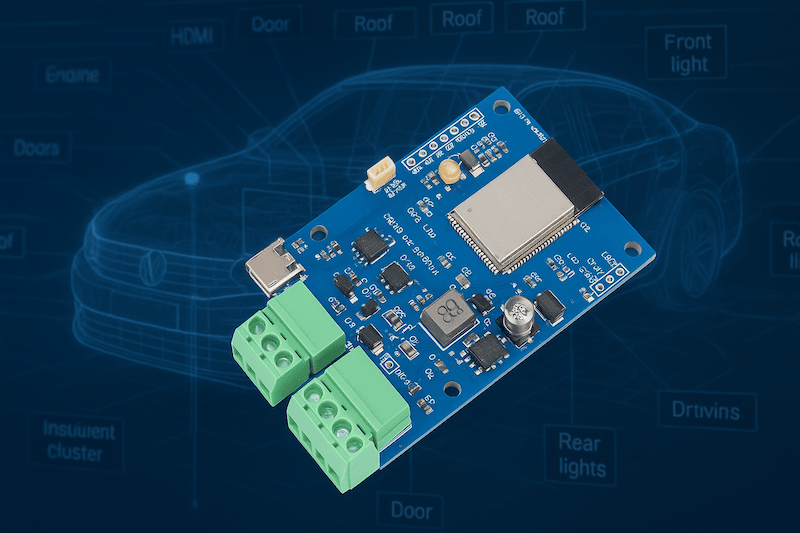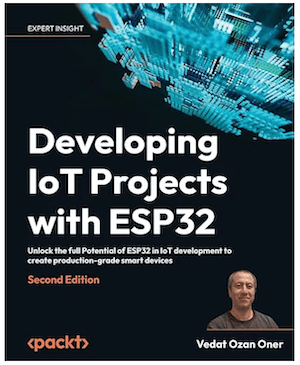Recent Posts
ESP32S3 CAN & LIN-Bus Board: A Powerful Platform for Automotive Networking
Posted by on
 In today’s vehicles, networking technologies such as CAN and LIN are essential for reliable communication between electronic control units (ECUs). From advanced driver-assistance systems to body electronics, these protocols form the backbone of modern automotive design. The ESP32S3 CAN & LIN-Bus Board was created with these exact needs in mind, offering engineers a versatile development platform that combines high-performance processing with native automotive bus support.
In today’s vehicles, networking technologies such as CAN and LIN are essential for reliable communication between electronic control units (ECUs). From advanced driver-assistance systems to body electronics, these protocols form the backbone of modern automotive design. The ESP32S3 CAN & LIN-Bus Board was created with these exact needs in mind, offering engineers a versatile development platform that combines high-performance processing with native automotive bus support.
High-Performance Processing Core
At the center of this board is the ESP32-S3-WROOM-1-N8R8 module, built on a dual-core Xtensa® LX7 processor running up to 240 MHz. The module provides 8 MB of QSPI flash and 8 MB of PSRAM, enabling developers to run complex applications, buffer data streams, and handle demanding real-time tasks. This processing headroom makes it suitable for gateway designs, ECU emulation, or advanced diagnostics.
Integrated CAN and LIN Support
The board includes an onboard CAN transceiver and a TJA1021T LIN transceiver, giving direct access to both communication standards without requiring additional hardware. Engineers can develop systems that bridge CAN and LIN, prototype body control modules, or evaluate new communication strategies across subsystems such as climate control, infotainment, or power management.
Wireless Connectivity for Automotive Applications
Beyond wired networking, the ESP32S3 offers integrated Wi-Fi 802.11 b/g/n and Bluetooth 5 (including Low Energy and mesh). This combination makes it easy to implement wireless diagnostics, mobile app integration, and over-the-air updates for in-vehicle systems—capabilities increasingly important in modern automotive environments.
Developer-Friendly Hardware Features
Practical development features include a USB-C programming interface, BOOT and RESET buttons for firmware flashing, and an RGB LED for system status indication. An onboard I²C header allows expansion with external sensors or modules, while the wide-range 7–14 V SMPS power input with reverse-polarity protection ensures robust operation in real-world automotive test setups.
Accelerating Automotive Prototyping
The ESP32S3 CAN & LIN-Bus Board is more than just a development tool—it is a rapid prototyping platform. With schematics and demo code provided, engineers can quickly begin experimenting with ECU simulations, LIN-controlled peripherals, or CAN-to-Bluetooth gateways. The board shortens development cycles by removing the need for external adapters, letting teams focus directly on application-level innovation.
Conclusion
For engineers working in automotive electronics, the ESP32S3 CAN & LIN-Bus Board provides a compact yet powerful platform that bridges modern wireless connectivity with established in-vehicle networking standards. By combining robust processing, dual-bus transceivers, and developer-friendly features, it offers the flexibility needed to build, test, and refine the next generation of automotive systems. More information...
 ESP32, the low-cost, energy-efficient system-on-a-chip (SoC) microcontroller, has become a cornerstone of modern Wi-Fi-enabled devices, driving innovation across the Internet of Things (IoT) landscape. This comprehensive guide offers a practical, end-to-end approach to building secure, scalable IoT systems using the powerful ESP32 platform.
ESP32, the low-cost, energy-efficient system-on-a-chip (SoC) microcontroller, has become a cornerstone of modern Wi-Fi-enabled devices, driving innovation across the Internet of Things (IoT) landscape. This comprehensive guide offers a practical, end-to-end approach to building secure, scalable IoT systems using the powerful ESP32 platform.
From foundational concepts to advanced implementation, the book walks you through the complete lifecycle of developing an IoT device with ESP32. Beginning with essential IoT principles and real-world use cases, each chapter progressively builds your skills—covering sensor communication, integration of key libraries like LittleFS and LVGL, Wi-Fi connectivity, data security, and cloud integration. You'll also learn how to visualize real-time data using tools like Grafana, making your solutions truly production-ready.
A special section is dedicated to artificial intelligence and machine learning (AI/ML) for embedded systems. You'll explore how to build and deploy tinyML models on the ESP32-S3, enabling intelligent edge computing capabilities for your next-generation embedded products.
Adopting a hands-on, project-driven approach, the book ensures that you can apply your knowledge from day one. As a capstone, you'll develop a full-scale Smart Home system, consolidating all the concepts and technologies explored throughout the book.
Whether you're a maker, engineer, or embedded systems developer, this book equips you to build secure, real-world IoT solutions with ESP32—ready for deployment in today’s connected world. More information...
 Loading... Please wait...
Loading... Please wait...
